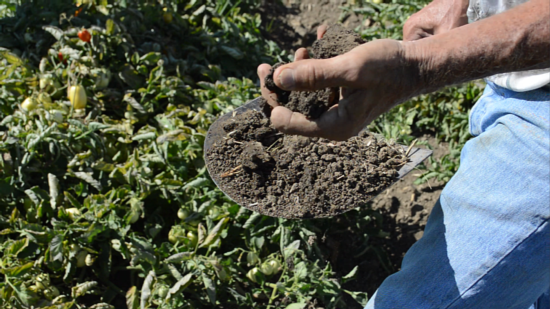Scott Park Farming
Scott Park farms about 1500 acres in Meridian, California. He currently leases and owns 22 separate fields, which are all certified organic by California Certified Organic Farmers. He grows a wide array of crops including corn, processing tomatoes, rice, wheat, beans, millet, stevia, vine seed, and herbs. Scott is a first generation famer with no formal education in agriculture. He started working on farms in the Meridian area in 1970, while in college. After graduating with his degree in Political Theory, a friend asked him join in on a partnership for a processing tomatoes farm. From 1974 to 1985, Scott grew processing tomatoes with conventional practices, but then he leased a new field that changed his perspective.

In the fall of 1985, Scott brought his farming equipment over to his newly leased field to rip the ground and prepare it for tomato planting. He was used to encountering hard soils that strained his heavy machinery while tilling and preparing the soils. But this new field “had soil like a garden,” it was easy to till—the machines worked with ease. This new field was quarter of a mile from a field that Scott had been farming for years, and he wondered what the different practices were, and how he could make the soil of all his fields like this one.
Acquiring this field started a long transition in Scott’s farming philosophy and his practices. He realized that his old practices were destroying his ground and soil- the foundation of his fields. And Scott began the slow process of change, “There is a huge learning curve,” says Scott, “Especially for me, I had no farming knowledge, and I made a lot of mistakes.” But he was encouraged along the way by the improvements he was seeing in his crop and soils.
Today, Scott’s main farming philosophy and approach to nutrient management is simple: "100% respect for the soil." Scott gears his practices towards keeping the soil healthy to support crop growth, increase water holding capacity and infiltration rates, and increase soil fertility. The nutrient management plan at Park Farming is based on rotational cropping, cover cropping, incorporating crop residue, and using organic soil amendments.
Rotational Cropping
“The idea with rotational cropping is that one crop helps the next crop,” Scott explains. His nutrient management plan is based on the timing of his crop planting, the nutrients each crop requires, and how each crop interacts with the soil. At Park Farming, they grow a variety of crops, and although the rotation for each field may vary, Scott says in an ideal world, he would have a four year cycle of: tomatoes, rice, beans, wheat, and tomatoes. In between cash crop plantings, he also uses cover crops and incorporates crop residues and straw. Scott breaks down the logic behind this rotational cropping pattern, where each crop interacts with the soils differently and provides a benefit for the next crop:

Cover Cropping
In between his cash crop plantings, Scott uses cover crop mixes. If he is planting the rotation outlined above, he plants cover crops between each season: between the tomatoes and rice, the rice and beans, and the wheat and tomatoes. Crop crops are an important source of organic matter and soil nutrients. They also prevent runoff and increase winter rain infiltration into the soils.
Scott’s ideal cover crop mix is a legume and a cereal mix, for example, a 6:1 vetch and wheat mix, which costs around $40 per acre. He prefers this mix because he gets good growth throughout the cover crop growing period, as the legume and the cereal grow at complimentary times. Scott seeds the cover crop in November and disks the crop into the soils in March, before the soils dry out. The moist soils are easier to cultivate
Cover Cropping for Tomatoes
In between the wheat and tomato seasons, Scott uses African Black Eyes as his cover crop. Organic tomato farmers often find it hard to cover crop. Ideally the tomatoes should be planted mid-March. But with many cover crop mixes, there is too much wet biomass to fully incorporate into the soil before mid-March, making it hard to plant tomatoes on-time. Conventional farmers can spray their cover crops in February to kill it, allowing the crop to dry and be incorporated into the soils earlier in the season. Scott and other organic farms do not use sprays. Scott plants African Black Eyes because they die with the first frost in November or December and then will be dry and can be incorporated into the soils early in the spring to be ready for the tomato planning.
Incorporating Crop Residue
Rice, wheat, and corn all produce straw and stalks after harvest. This is a source of organic matter that can be used to build soil structure and health. After every season of these crops, Scott will lay down the straw from the crop on the field. He may irrigate the straw as well, to encourage natural weed growth and then disc the field to incorporate all the organic matter into the soils and remove the weeds to prepare for the next crop.
Organic Soil Amendments
In addition to the nutrients provided by the crop rotations, cover crops, and incorporation of crop residue and organic matter, Scott adds soil amendments as needed. He spreads a green waste compost, chicken litter, and seaweed. He generally adds about 4 tons per acre of chicken litter and will add the compost when seeding the cover crop. Scott adds chicken manure by experience, but tries to keep his applications on the lighter side.
Scott also adds microbial stimulants, seaweed, and gypsum as needed.
Irrigation
Scott furrow irrigates his fields. He has a couple of fields that are on drip, but prefers furrow irrigation for a few reasons. One advantage with drip irrigation is fertigation, growers can pump liquid fertilizers through the drip lines; however, Scott uses compost and chicken manure, which is spread on the fields. Chicken manure costs between $0.75-$1 per lb, as opposed to around $8.25 per pound of liquid nitrogen fertilizers. Also, installing a drip system is expensive, and not economically or logistically feasible with his rotational cropping. For example, he could not follow tomatoes with rice in the same field with a drip system installed.
Even though furrow irrigation is less efficient than drip irrigation, Scott has seen the infiltration rate and water holding capacity of his soils increase, decreasing the amount he has to irrigate overtime. Scott also drills his rice into moisture, unlike most rice growers who flood. Although he does flood his field later, drilling rice reduces water use, eliminates algae problems, cold water check problems, and lodging. Scott uses about 2.2 acre-feet of irrigation water on the tomatoes a year, compared to the average 1.5 acre-feet used by those using drip systems.
Scott uses surface water from two irrigation districts and has backup wells. Nitrates in the irrigation water are not a large concern in his area, but they do test the water for salts.
Profit, Environment, People
“This is my PEP Statement,” Scott says, “Profit, Environment, and People; I want it all to be better off.” With the rotational cropping, Scott has a crew that works all year, except around the winter holidays. He employs 8 full season and 3 part-time employees, one employee has been with him 37 years.
And of course, farming is a business. “It has been hard financially,” Scott admits. But Scott works to build solid and reliable relationships with his buyers, has diversified his risk, and sees a stable market for organic produce.
“I’ve seen the ground, the environment, and the water all improving from our practices,” Scott says.
Soil tests show increases in organic matter, and he has observed changes in his soil—increased sponginess and structure. But more than that, the whole system at Park Farming is working with the environment to capitalize on the fertility and the organic matter of the crop grown to benefit soil heath, fertility, and structure, without synthetic pesticides and herbicides. Scott preserves native vegetation, trees and grasses, on the edges of his fields that provides habitat for pollinators.
“People say you can’t get good fertility with Organics, but just look at these fields! It can be done.”
Some of Scott’s fields have been rotationally cropped with cover crops, compost, and organic material for 27 years, and the result is healthy and fertile soil that supports his crop.
